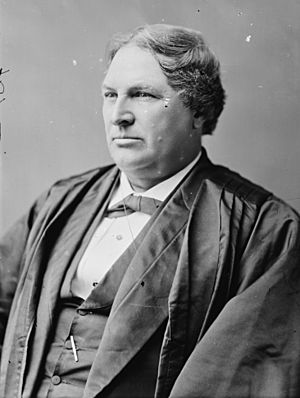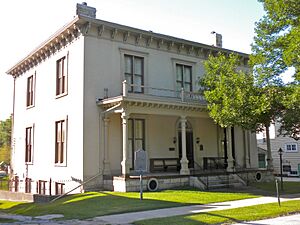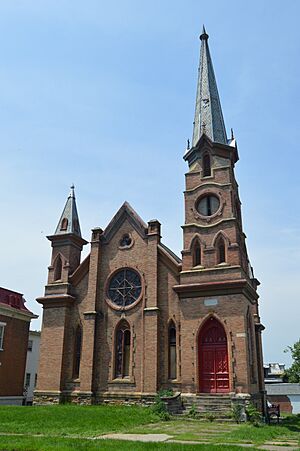Samuel Freeman Miller facts for kids
Quick facts for kids
Samuel Freeman Miller
|
|
|---|---|

Samuel Freeman Miller, by Mathew Brady, c. 1865-75
|
|
| Associate Justice of the Supreme Court of the United States | |
| In office July 21, 1862 – October 13, 1890 |
|
| Nominated by | Abraham Lincoln |
| Preceded by | Peter Daniel |
| Succeeded by | Henry Billings Brown |
| Personal details | |
| Born | April 5, 1816 Richmond, Kentucky, U.S. |
| Died | October 13, 1890 (aged 74) Washington, D.C., U.S. |
| Political party | Whig (Before 1854) Republican (1854–1890) |
| Education | Transylvania University (MD) |
| Signature | |
Samuel Freeman Miller (born April 5, 1816 – died October 13, 1890) was an important American lawyer and doctor. He became a judge on the U.S. Supreme Court in 1862. He served there until he died in 1890. He wrote some very important decisions, like in the Slaughterhouse Cases.
Contents
Early Life and Learning
Samuel Miller was born in Richmond, Kentucky. His father, Frederick Miller, was a farmer. In 1838, Samuel earned a medical degree from Transylvania University in Lexington.
He worked as a doctor for ten years in Barbourville, Kentucky. During this time, he taught himself about law. He became a lawyer in 1847. Miller did not support slavery, which was common in Kentucky. He was part of the Whig Party.
A Career in Law and Politics
In 1850, Miller moved to Keokuk, Iowa. Iowa was a state where his views against slavery were more accepted. He immediately freed the few enslaved people who had come with his family from Kentucky.
Miller was very active in Iowa politics. He supported Abraham Lincoln in the 1860 election for president. President Lincoln chose Miller to join the Supreme Court on July 16, 1862. The U.S. Senate quickly approved him that same day. He officially started his job on July 21.
Important Court Decisions
As a judge, Miller strongly supported President Lincoln's ideas. He agreed with Lincoln's decision to temporarily stop habeas corpus during the war. This meant people could be held without a quick court hearing. He also supported trials by military courts during wartime.
After the war, Miller wrote a key decision in the 1873 Slaughterhouse Cases. His interpretation of the Fourteenth Amendment made it less powerful. This amendment was meant to protect the rights of newly freed people.
Miller also wrote the main opinion in Bradwell v. Illinois. This case decided that the right to be a lawyer was not protected by the Constitution. Later, he agreed with decisions in United States v. Cruikshank and the Civil Rights Cases. These cases said the government could not stop private groups from discriminating against Black people. However, in Ex parte Yarbrough (1884), Miller said the government could protect Black voters from groups like the Ku Klux Klan.
Miller believed the federal government had strong power to control trade between states. This was shown in the case Wabash v. Illinois.
Miller's Influence on the Court
Justice Miller wrote many opinions during his 28 years on the Supreme Court. He wrote 616 opinions, which was more than many other important judges. For example, Chief Justice John Marshall wrote 508 opinions in 33 years.
When Chief Justice Salmon P. Chase died in 1873, many lawyers wanted Miller to take his place. But President Ulysses S. Grant chose someone else, Morrison Waite.
Miller also helped decide the very close 1876 presidential election. He was part of a special group that gave the disputed votes to Rutherford Hayes. In the 1880s, some people even thought he might run for president.
In 1889 and 1890, Justice Miller gave a series of talks about constitutional law. These talks were later published as a book.
Personal Life
Miller was a religious person who belonged to the Unitarian Church. He was even the president of their national group. He died in Washington, D.C., while still serving on the Supreme Court.
His funeral was held at the First Unitarian Church in Keokuk, Iowa. Miller had helped start that church. He is buried in Oakland Cemetery in Keokuk.
Samuel Miller married Lucy Love Ballinger Miller in 1842. They had three daughters. After Lucy died in 1854, he married Eliza Winter Reeves in 1856. They had a son and a daughter.
Notable Opinions by Justice Miller
- Watson v. Jones, 80 U.S. 679 (1871)
- The Slaughter-House Cases, 83 U.S. 36 (1873)
- Murdock v. Memphis, 87 U.S. 20 Wall. 590 590 (1874)
- United States v. Kagama, 118 U.S. 375 (1886)
- In re Neagle, 135 U.S. 1 (1890)
- In re Burrus, 136 U.S. 586 (1890)
See also
- Justice Samuel Freeman Miller House, a historic home in Iowa
- List of justices of the Supreme Court of the United States



